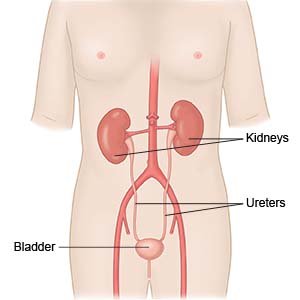Laparoscopic Live Donor Nephrectomy
Medically reviewed by Drugs.com. Last updated on Aug 4, 2025.
WHAT YOU NEED TO KNOW:
Laparoscopic live donor nephrectomy is surgery to remove a kidney for transplant to another person. Laparoscopic surgery is done through small incisions made in your side.
 |
HOW TO PREPARE:
The week before your surgery:
- Arrange to have someone drive you home after surgery.
- Tell your surgeon about all medicines you currently take. He or she will tell you if you need to stop any medicine for surgery, and when to stop. He or she will tell you which medicines to take or not take on the day of surgery.
- You may need to have blood and urine tests. You may also need an ECG, x-rays, a CT scan, an MRI, or a renal arteriography.
The night before your surgery:
- You may be told not to eat or drink anything after midnight.
- Bowel preparation will help clean out your bowels before surgery. Your healthcare provider may ask you to use an enema, bowel prep medicine, or both. An enema uses medicine or warm water that is put into your rectum to help empty your bowel. Bowel prep medicine comes as a liquid to drink.
The day of your surgery:
- Take only the medicines your surgeon told you to take.
- Do not eat or drink anything on the morning of your surgery. Your bowel needs to be empty during your surgery. If you need to take medicines, take them with small sips of water. You may need an additional enema the morning of your surgery. You may also be asked to drink more bowel prep medicine.
- An anesthesiologist will talk to you before your surgery. You may need medicine to keep you asleep or numb an area of your body during surgery. Tell healthcare providers if you or anyone in your family has had a problem with anesthesia in the past.
- You or a close family member will be asked to sign a legal document called a consent form. It gives healthcare providers permission to do the procedure or surgery. It also explains the problems that may happen, and your choices. Make sure all your questions are answered before you sign this form.
- An IV will be put in a vein. You may get liquid or medicines through the IV.
WHAT WILL HAPPEN:
What will happen:
- General anesthesia will be given to keep you asleep and free from pain during the surgery.
- Your surgeon will make 3 to 5 small incisions in your side where tools will pass through. Your abdomen will be filled with gas (carbon dioxide) to lift the abdominal wall so your surgeon can see the kidney better. He or she will use the instruments to tie, clamp, or cut blood vessels. The kidney will be removed through a larger incision in your abdomen.
- The incisions will be closed with stitches and covered with bandages.
After your surgery:
You will be taken to a room to rest until you are fully awake. Healthcare providers will monitor you closely for any problems. Do not get out of bed until your healthcare provider says it is okay. When your healthcare provider sees that you are okay, you will be taken to your hospital room. The bandages used to cover your stitches keep the surgery area clean and dry to prevent infection. A healthcare provider may remove the bandages to check the area.
CONTACT YOUR HEALTHCARE PROVIDER IF:
- You cannot make it to your surgery.
- You have a fever.
- You get a cold or the flu.
- You have questions or concerns about your surgery.
Risks
You may get an infection or bleed more than expected. You may have trouble breathing. Your laparoscopic surgery may need to become an open surgery if problems develop. Nerves, blood vessels, muscles, intestines, and other organs may be damaged. The gas used during the surgery may cause shoulder or chest pain for 1 to 2 days after your surgery. You may get a blood clot in your leg or arm. This may become life-threatening.
Care Agreement
You have the right to help plan your care. Learn about your health condition and how it may be treated. Discuss treatment options with your healthcare providers to decide what care you want to receive. You always have the right to refuse treatment.© Copyright Merative 2025 Information is for End User's use only and may not be sold, redistributed or otherwise used for commercial purposes.
The above information is an educational aid only. It is not intended as medical advice for individual conditions or treatments. Talk to your doctor, nurse or pharmacist before following any medical regimen to see if it is safe and effective for you.
Further information
Always consult your healthcare provider to ensure the information displayed on this page applies to your personal circumstances.
